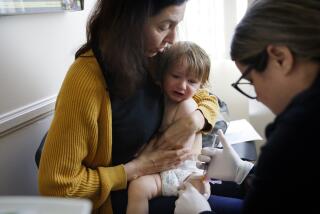2019 is shaping up to be the worst year for measles since ’90s, CDC data show

More than 200 cases of measles were confirmed in the United States in the first two months of the year, with outbreaks occurring in 11 states, according to new figures from the Centers for Disease Control and Prevention.
The 206 cases in January and February represent the highest year-to-date number going back more than a quarter-century.
When measles struck, investigators wanted answers. Instead, some parents lied »
The data underscore how anti-vaccine sentiment and the rising incidence of vaccine refusal threaten to revive a public health threat that had been declared eliminated nearly 20 years ago. Scientists agree that vaccines are extremely safe and very effective.
The number of new measles cases in the first two months of this year already surpasses the entire annual totals of all but three years since the disease was declared eliminated in 2000. An outbreak in Washington state has sickened at least 71 people, and nearly all of those cases involve children who weren’t vaccinated against the disease.
The illness typically begins with cold-like symptoms, including a high fever, cough and runny nose. After a few days, patients may develop a rash that spreads from the face to the rest of the body, as well as small white spots inside the mouth. Ear infections and diarrhea are common complications, according to the CDC.
In about 5% of cases involving children, measles can lead to pneumonia. In addition, about one in every 1,000 children with measles develops dangerous swelling in the brain that can cause convulsions, deafness and intellectual disabilities.
“For every 1,000 children who get measles, one or two will die from it,” the CDC says.
The unusually large number of cases early in the year doesn’t necessary portend a record high annual total in 2019. In 2015, for instance, there were 154 cases in the first two months of the year followed by just 34 for the remainder of the year, putting it at right about average relative to the past decade’s annual totals.
In addition to the cases in Washington, there are ongoing measles outbreaks in New York, Texas and Illinois, according to the CDC.
“These outbreaks are linked to travelers who brought measles back from other countries such as Israel and Ukraine, where large measles outbreaks are occurring,” the agency noted on its website.
In recent years, groups opposed to vaccines have been able to cultivate large followings on internet platforms such as Facebook and YouTube. Growing public outcry over those companies’ inaction in response to the spread of misinformation about vaccines led both companies to address the problem in recent weeks.
In late February, YouTube said it was taking steps to prevent anti-vaccine channels from making money off their videos. This week, Facebook announced it would be reducing the visibility of anti-vaccine pages on Facebook and Instagram.
That move followed congressional testimony from Ethan Lindenberger, a high school senior who described how his mother got anti-vaccine information almost exclusively from Facebook. Lindenberger got his vaccinations himself when he turned 18.
Christopher Ingraham writes for the Washington Post.






